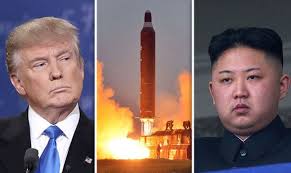THE UNITED STATES INTEREST BEHIND THE NORTH KOREA MISSILE CRISIS
DOI:
https://doi.org/10.25299/jdis.2019.vol2(01).4424Keywords:
missile, technology, conflict promotionAbstract
Conflict in the Korean Peninsula has been started since the Korean war 1950-1953, and still, there is no peaceful achievement to end it. Several efforts have been held to solve peacefully, such as bringing North Korea to be a part of the Non-Proliferation Treaty (NPT). U.S. former president, Jimmy Carter, also initiated Agreed Framework, a scheme of resolution of nuclear energy by involving the United States, South Korea, and Japan. Since 2003, Russia, China joint to the United States, South Korea, Japan, and North Korea to start the negotiation over nuclear issues in North Korea, but after the fifth round of these series, no significant achievement attained. Since there is still a threat to Japan and South Korea, the U.S. presence in East Asia gets raison detre’. Besides, there are chances to U.S. in this conflictual situation to promote its weaponry system. Based on its experience in the Gulf War, the United States can also introduce and sell weaponry system, especially the missile technology. This paper tries to explore the advantage of the U.S. in the conflictual situation.
Downloads
References
Berlinger, J., & Ullah, Z. (2017, September 23). North Korea Could Test Hydrogen Bomb Over Pacific Ocean, Says Foreign Minister. CNN.
Blank, S. (2007). The end of the Six-Party Talks? Strategic Insight, VI(1).
Gnaedinger, A. (n.d.). War and Business Entreprises. Journal of Financial Transformation. Retrieved from https://www.icrc.org/eng/assets/files/other/journal_vol17_laureate_02.pdf
Lee, S. (2010). U.S. Arms Sales to Taiwan Domestic Pressures on U.S.-China relations. Policy Brief, 7.
Lostumbo, M. J. (2013). Overseas Basing of U.S.. Military Forces. In National Defense Research Institute. Retrieved from https://www.rand.org/content/dam/rand/pubs/research_reports/RR200/RR201/RAND_RR201.pdf
Revere, E. (2016). The U.S.-ROK Alliance: Projecting U.S. Power and Preserving Stability in Northeast Asia. Retrieved from https://www.brookings.edu/wp-content/uploads/2016/07/Paper-3.pdf
Shimbun, A., & Kato, Y. (n.d.). The U.S.. Military Presence in Japan in the Context of the "Rebalance" to the Asia-Pacific. Retrieved from https://www.suntory.com/sfnd/jgc/forum/006/pdf/006_kato_en.pdf
Sulivan, J. (1999). Technical Debate Over Patriot Performance in The Gulf War. Journal Science and Global Security, 8.
Zhou, L. (2017, October 6October 6). U.S.. Super Carrier to Dock in Hong Kong before Joint Drills in Shadow of North Korea Crisis. South China Morning Post.







